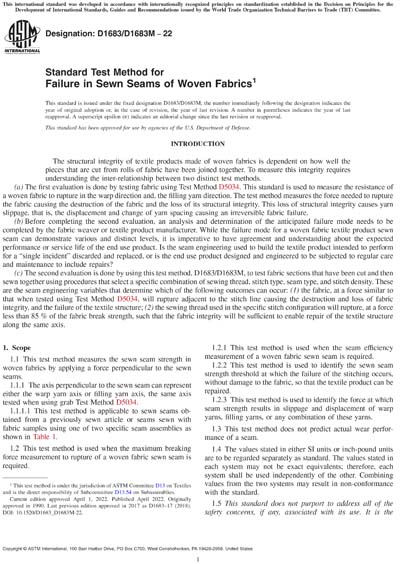Most recent
ASTM D1683/D1683M-22
Standard Test Method for Failure in Sewn Seams of Woven Fabrics
1.1This test method measures the sewn seam strength in woven fabrics by applying a force perpendicular to the sewn seams.
1.1.1The axis perpendicular to the sewn seam can represent either the warp yarn axis or filling yarn axis, the same axis tested when using grab Test Method D5034.
1.1.1.1This test method is applicable to sewn seams obtained from a previously sewn article or seams sewn with fabric samples using one of two specific seam assemblies as shown in Table 1.
Note 1:When the performance of a woven textile structure requires data to indicate the maximum seam strength that will result in the failure of fabric on either side of seam, the standard seam can be changed to use the Lapped seam type construction with two or more rows of stitching: Lsc-2; Lsc-3; Lsc-4; and the maximum number of stitches per inch that can be used. (See Practice D6193.)
1.2This test method is used when the maximum breaking force measurement to rupture of a woven fabric sewn seam is required.
1.2.1This test method is used when the seam efficiency measurement of a woven fabric sewn seam is required.
1.2.2This test method is used to identify the sewn seam strength threshold at which the failure of the stitching occurs, without damage to the fabric, so that the textile product can be repaired.
1.2.3This test method is used to identify the force at which seam strength results in slippage and displacement of warp yarns, filling yarns, or any combination of these yarns.
1.3This test method does not predict actual wear performance of a seam.
1.4The values stated in either SI units or inch-pound units are to be regarded separately as standard. The values stated in each system may not be exact equivalents; therefore, each system shall be used independently of the other. Combining values from the two systems may result in non-conformance with the standard.
1.5This standard does not purport to address all of the safety concerns, if any, associated with its use. It is the responsibility of the user of this standard to establish appropriate safety, health, and environmental practices and determine the applicability of regulatory limitations prior to use.
1.6This international standard was developed in accordance with internationally recognized principles on standardization established in the Decision on Principles for the Development of International Standards, Guides and Recommendations issued by the World Trade Organization Technical Barriers to Trade (TBT) Committee.
ASTM International [astm]

